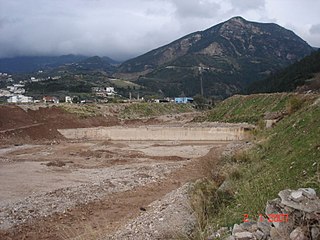
A blueprint is a reproduction of a technical drawing using a contact print process on light-sensitive sheets. Introduced by Sir John Herschel in 1842, the process allowed rapid, and accurate, production of an unlimited number of copies. It was widely used for over a century for the reproduction of specification drawings used in construction and industry. The blueprint process was characterised by white lines on a blue background, a negative of the original. The process was not able to reproduce color or shades of grey.

The art, science, and technology of papermaking addresses the methods, equipment, and materials used to make paper and cardboard, these being used widely for printing, writing, and packaging, among many other purposes and useful products. Today almost all paper is manufactured using industrial machinery, while handmade paper survives as a specialized craft and a medium for artistic expression.

The Bureau of Engraving and Printing (BEP) is a government agency within the United States Department of the Treasury that designs and produces a variety of security products for the United States government, most notable of which is Federal Reserve Notes for the Federal Reserve, the nation's central bank. In addition to paper currency, the BEP produces Treasury securities; military commissions and award certificates; invitations and admission cards; and many different types of identification cards, forms, and other special security documents for a variety of government agencies. The BEP does not produce coins; all coinage is produced by the United States Mint. With production facilities in Washington, D.C., and Fort Worth, Texas, the Bureau of Engraving and Printing is the largest producer of government security documents in the United States.

The Globe and Mail is a Canadian newspaper printed in five cities in western and central Canada. With a weekly readership of 2,018,923 in 2015, it is Canada's most widely read newspaper on weekdays and Saturdays, although it falls slightly behind the Toronto Star in overall weekly circulation because the Star publishes a Sunday edition while the Globe does not. The Globe and Mail is regarded by some as Canada's "newspaper of record". The newspaper is owned by The Woodbridge Company, based in Toronto.

The Houston Chronicle is the largest daily newspaper in Houston, Texas, United States. As of April 2016, it is the third-largest newspaper by Sunday circulation in the United States, behind only the New York Times and Los Angeles Times. With its 1995 buy-out of long-time rival the Houston Post, the Chronicle became Houston's newspaper of record.
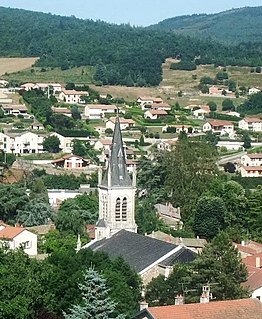
Saint-Marcel-lès-Annonay is a commune in the Ardèche department in southern France.

Building material is any material which is used for construction purposes. Many naturally occurring substances, such as clay, rocks, sand, and wood, even twigs and leaves, have been used to construct buildings. Apart from naturally occurring materials, many man-made products are in use, some more and some less synthetic. The manufacturing of building materials is an established industry in many countries and the use of these materials is typically segmented into specific specialty trades, such as carpentry, insulation, plumbing, and roofing work. They provide the make-up of habitats and structures including homes.

The Midland Railway Carriage and Wagon Company was a Birmingham, England, based manufacturer of railway carriages and wagons. It was not part of the Midland Railway.

Papier-mâché is a composite material consisting of paper pieces or pulp, sometimes reinforced with textiles, bound with an adhesive, such as glue, starch, or wallpaper paste.
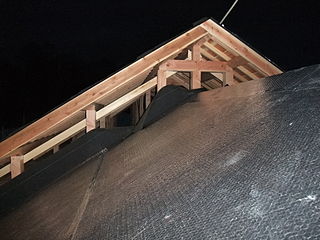
Tar paper is a heavy-duty paper used in construction. Tar paper is made by impregnating paper or fiberglass mat with tar, producing a waterproof material useful for roof construction. Tar paper is distinguished from roofing felt which is impregnated with asphalt instead of tar; but these two products are used the same way, and their names sometimes are used informally as synonyms.

The Ottawa Citizen is an English-language daily newspaper owned by Postmedia Network in Ottawa, Ontario, Canada.

Shigeru Ban is a Japanese architect, known for his innovative work with paper, particularly recycled cardboard tubes used to quickly and efficiently house disaster victims. He was profiled by Time magazine in their projection of 21st-century innovators in the field of architecture and design.
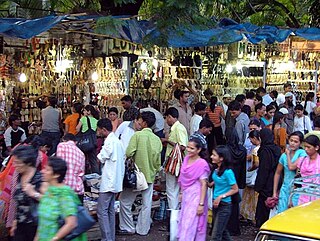
Fashion Street refers to a cluster of over 385 street side clothing shops on MG Road near Azad Maidan and is opposite to Bombay Gymkhana, in South Mumbai, India.

Tracing paper is paper made to have low opacity, allowing light to pass through. It was originally developed for architects and design engineers to create drawings which could be copied precisely using the diazo copy process; it then found many other uses. The original use for drawing and tracing was largely superseded by technologies which do not require diazo copying or manual copying of drawings.

The Montreal Gazette, formerly titled The Gazette, is the only English-language daily newspaper published in Montreal, Quebec, Canada, after three other daily English newspapers shut down at various times during the second half of the 20th century. It is one of the French-speaking province's last two English-language dailies; the other is the Sherbrooke Record, which serves the anglophone community in the Eastern Townships southeast of Montreal.

The Sheboygan Press is a daily newspaper based in Sheboygan, Wisconsin, United States. It is one of a number of newspapers in the state of Wisconsin owned by the Gannett Company, including the Milwaukee Journal Sentinel, Green Bay Press-Gazette and Appleton's The Post-Crescent, along with the nearby Herald Times Reporter of Manitowoc. The Sheboygan Press is primarily distributed in Sheboygan County.

The Spokane Daily Chronicle was a daily newspaper in Spokane, Washington. It was founded as a weekly paper in 1881 and grew into an afternoon daily, competing with The Spokesman-Review, which was formed from the merger of two competing papers.

The Barrier Miner was a daily English language broadsheet newspaper published in Broken Hill in far western New South Wales from 1888 to 1974.
Paper Hall is a Grade II* listed building in Bradford, West Yorkshire, England noted for being the oldest domestic building in the city centre and for housing the city's first spinning machines. Its then owner James Garnett is credited with bringing the industrial revolution to Bradford which became one of the manufacturing centres of Britain in the 19th century.
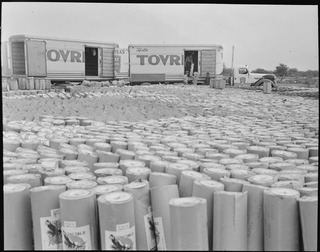
Red rosin paper is a 100% recycled heavy duty felt paper used in construction such as underlayment under flooring and siding. The name "rosin-sized sheathing paper", commonly used to describe the material, comes from the rosin used in the paper, the process of sizing it to add the rosin, and its use by builders. "Alum-rosin size was invented by Moritz Friedrich Illig in Germany in 1807..." and is known to have been used as a building paper by 1850.

